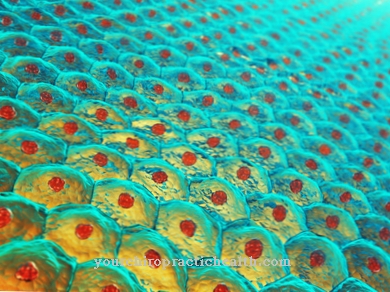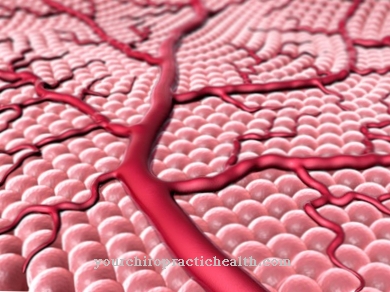The epicritical sensitivity is and is a perception system of the skin Sharpness of touch or Fine perception called. It is closely related to proprioception. Disorders of the epicritical sensitivity are often caused by peripheral or central nerve damage.
What is the Epicritical Sensitivity?

The human skin senses have different perceptual qualities, which are summarized as surface sensitivity. One of them is epicritical sensitivity. These are the discriminatory perceptions of vibrations, pressure and touch, which are also known as fine perception. In addition, the epicritical sensitivity includes perceptions of the proprioceptive sense of position and is therefore involved in the interoception of internal stimuli as well as in the exteroception of external stimuli.
Epicritical sensitivity works with various sensory cells that translate a stimulus into the language of the central nervous system. The epicritical receptors are either exteroceptors or interoceptors. The exteroceptors of epicritical sensitivity are predominantly mechanoreceptors for obtaining information about the localization or fine-tuning of a touch. Proprioceptors such as muscle spindles and tendon spindles are relevant as epicritical interoceptors, which are used to obtain information about the position of muscles and joints.
Protopathic sensitivity must be distinguished from epicritical sensitivity. This second quality of perception of the skin sense provides information on temperatures and pain via thermoreceptors and nociceptors and is also referred to as predominantly exteroceptive coarse perception.
As part of tactile perception, epicritical sensitivity, in contrast to protopathic sensitivity, means the ability to perceive spatially closely spaced touch stimuli as individual stimuli. Fine perception plays a role for both tactile and haptic perception, in the sense of passive and active tactile perception.
Function & task
The epicritical perceptual system is also known as the discriminating system of skin sense. In contrast, the protopathic system of the skin's senses corresponds to a protective system. Epicritical perception can be broken down into passive touch perception and active exploratory perception.
All proprioceptive structures of the system are passive touch-perception structures. The first place for the perception of epicritical information are the receptors. In this context, mechanoceptors such as pressoreceptors and baroreceptors are distinguished from proprioceptors such as muscle spindles. The mechanoceptors are mainly concerned with pressure perception. Proprioceptors are responsible for self-awareness. Beroreceptors, for example, are located in the wall of blood vessels and are involved in the enteroceptive regulation of blood pressure.
Mechanoreceptors are mainly divided into SA, RA and PC receptors. The most important SA receptors are the Merkel cells, the Ruffini bodies and the Pinkus Iggo tactile disks for pressure perception. Important RA receptors are the Meissner bodies, the hair follicle sensors and the Krause end bulbs for perception of touch. The Vater-Pacini corpuscles and the Golgi-Mazzoni corpuscles are mainly known as PC receptors for vibration perception.
In connection with proprioception, enteroceptive receptors are differentiated from purely proprioceptive receptors. Via enteroceptive epicritical receptors in the bladder, the gastrointestinal tract or the cardiovascular system, automatically controlled body processes such as the urge to urinate, the urge to defecate, the cough reflex or the filling of the auricles are regulated.
All epicritical information is forwarded for all exteroceptive stimuli via the posterior cord tracts of the spinal cord. The protopathic receptors of the skin sense, on the other hand, transmit their information to the cerebellum via the anterior spinocerebellar tract or the posterior posterior spinocerebellar tract. The Hinterstrangbahnen as afferent information path of the epicritical sensitivity run uncrossed.
The gracilis fasciculus is responsible for the information that affects the lower extremities. The cuneatus fasciculus, on the other hand, conducts the epicritical information of the upper extremities. The first neuron undergoes a switchover to the second neuron in the nucleus gracilis or nucleus cuneatus of the brain stem. After this switchover, the orbits continue as the lemniscus medialis and cross within the decusatio lemniscorum. In the thalamus they are switched to a third neuron, which then transports the epicritical information to the postcentral gyrus.
As part of tactile perception, the epicritical sensitivity in terms of tactile acuity is determined using a two-point discrimination threshold. In young people, the sensitivity of the fine perception is around 1.5 millimeters at the fingertip. In older people it is sometimes only four millimeters. For physiological reasons, the tactile acuity of fine perception is lowest on the back and is a few centimeters.
You can find your medication here
➔ Medicines for paresthesia and circulatory disordersIllnesses & ailments
The most important task of the epicritical system is the assessment and differentiation of key impressions and touch impressions. Disturbances of the epicritical system manifest themselves mainly in the inability to distinguish between touch and touch.
All disorders of the surface sensitivity are most often due to damage to peripheral or central nerves. A lack of sensory integration can also be decisive for disorders of epicritical sensitivity. On the one hand, a sensory integration disorder is due to predisposition and manifests itself in the inability to combine different sensory impressions. On the other hand, it can arise from a lack of physical practice in childhood.
The ability to combine different sensory impressions is particularly crucial for near senses such as the epicritical system and can be increased if necessary with a disposition. Epicritical sensory disturbances are expressed either as hyperesthesia or as anesthesia. Hyperesthesia corresponds to increased perception or hypersensitivity to touch stimuli and can be painful.
Hyperesthesias often arise due to acute or chronic irritation of nerve structures, for example after operations or other interventions. Those affected often show a tactile defense that manifests itself in avoiding contact.
The opposite phenomenon is anesthesia, which amounts to numbness. Anesthesia with a local limitation shows up, for example, in peripheral polypathies in a certain part of the body, such as those caused by poisoning, diabetes or certain infections. Local anesthesia is just as often the result of damage to the central nervous system as part of a neurological disease such as multiple sclerosis, a stroke or a spinal cord infarction. Traumatic damage to the central nervous system can also be a possible cause. The same applies to tumor diseases of the central nervous system.






.jpg)

















.jpg)



